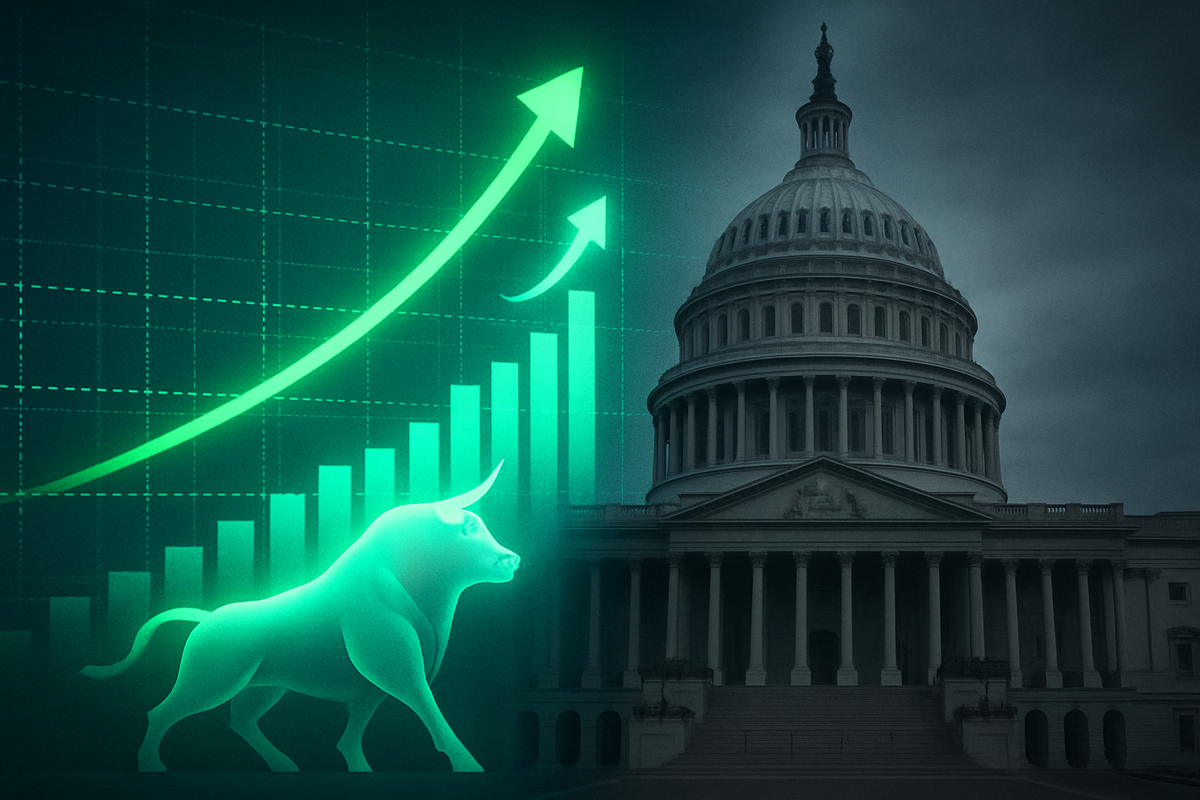
The U.S. financial markets are currently presenting a perplexing paradox. As of October 4, 2025, both the S&P 500 and Dow Jones Industrial Average (DJIA) have surged to unprecedented record highs, exhibiting remarkable resilience. This bullish momentum, however, unfolds against a backdrop of significant political turmoil: the federal government is in the midst of its fourth day of a shutdown, the first in seven years, due to protracted budget disagreements between Congress and the White House. This striking divergence underscores a market increasingly driven by robust corporate fundamentals and strategic optimism, seemingly impervious to the immediate political instability emanating from Washington D.C., though underlying concerns continue to simmer beneath the surface.
This unusual market behavior highlights a growing disconnect between political machinations and investor sentiment, suggesting that market participants are either confident in a swift resolution to the government shutdown or are prioritizing other economic indicators. The record-setting performance of major indices points to a deeply rooted strength in specific sectors and an overarching belief in the long-term trajectory of the American economy, even as the gears of government grind to a halt.
Unpacking the Market's Unfazed Ascent Amidst Washington's Impasse
As of October 3, 2025, the S&P 500 closed at an impressive 6,715.79, having touched an all-time high of 6,754.26 earlier in the month, and marking a fresh intraday record just two days prior. This robust performance contributed to a 3.5% gain for the index in September—its best September since 2010—and a 1.1% advance for the week ending October 3, culminating in a remarkable 14% year-to-date increase. Similarly, the Dow Jones Industrial Average (DJIA) closed at 46,758.28 on October 3, also reaching a new all-time high alongside the S&P 500 and Nasdaq Composite. The DJIA posted a 0.5% gain on October 3 and a 1% increase for the week, pushing its year-to-date growth to 10%.
This market exuberance is occurring precisely as the U.S. federal government entered its fourth day of a shutdown on October 4, 2025. The shutdown, which began on October 1, is the first in seven years and the third under President Donald Trump's administration. It stems from an intractable budget dispute where Senate Democrats rejected a House funding bill that notably omitted extensions for Affordable Care Act (ACA) subsidies, which are slated to expire at the end of 2025. Reports indicate that President Trump’s administration has frozen funds for Democratic-led states, a move that some Republicans fear could prolong the stalemate. Consequently, non-essential government services have ceased, and hundreds of thousands of federal employees are either furloughed or working without pay. A significant immediate concern for the financial community is the delay in the release of crucial economic data, such as the September jobs report and the consumer price index, creating an "economic data blackout" that complicates decision-making for both investors and the Federal Reserve. Despite these disruptions, the market's initial reaction has been largely one of resilience, with investors seemingly compartmentalizing the political drama from their investment decisions, at least in the short term.
Corporate Fortunes: Winners and Losers in a Divided Landscape
The current market environment, characterized by record highs amidst political uncertainty, creates a distinct landscape of winners and losers among public companies. Companies with strong fundamentals, particularly those in sectors less directly reliant on immediate government spending or regulatory clarity, are poised to benefit. Technology giants, for instance, continue to be significant drivers of market growth. Companies like Apple (NASDAQ: AAPL), Microsoft (NASDAQ: MSFT), and Alphabet (NASDAQ: GOOGL) are often seen as resilient due to their global revenue streams and robust innovation pipelines, especially in areas like Artificial Intelligence (AI). Nvidia (NASDAQ: NVDA), for example, has been a standout performer, reaching new all-time highs on the back of intense AI enthusiasm, demonstrating how strong sectoral trends can override broader political concerns. Healthcare, particularly companies focused on pharmaceuticals, biotechnology, and medical devices, also tends to exhibit stability, as demand for their products and services is less cyclical and less directly impacted by short-term government shutdowns. Companies like Johnson & Johnson (NYSE: JNJ) and Eli Lilly (NYSE: LLY) could continue to see steady performance.
Conversely, sectors and companies with significant exposure to government contracts, regulatory processes, or consumer confidence tied to federal operations are more vulnerable. Defense contractors like Lockheed Martin (NYSE: LMT) or Boeing (NYSE: BA) could face delays in contract approvals or payments, although their long-term pipelines often provide a buffer. Smaller businesses and startups, especially those seeking government grants or regulatory approvals, might experience significant operational disruptions and cash flow issues. Companies in the travel and leisure industry, such as airlines like Delta Air Lines (NYSE: DAL) or hotel chains, could see a dip in demand if prolonged shutdowns dampen consumer confidence or affect federal employee travel. Furthermore, financial institutions like JPMorgan Chase (NYSE: JPM) or Bank of America (NYSE: BAC) might face indirect impacts from delayed economic data, which can obscure the true state of the economy and complicate lending decisions, even if direct operations remain largely unaffected. The prolonged absence of critical economic reports creates an information vacuum that can breed uncertainty, potentially leading to increased volatility for companies whose valuations are highly sensitive to macroeconomic indicators.
Broader Implications: A New Era of Market Resilience or a Looming Reckoning?
This striking divergence between a soaring stock market and a stalemated government carries significant wider implications, hinting at evolving market dynamics and potential long-term shifts. One key aspect is how this event fits into broader industry trends. The sustained strength of the technology sector, fueled by innovations in AI and digital transformation, suggests a market increasingly prioritizing growth narratives that transcend traditional economic cycles. This trend indicates that investors are placing higher value on companies demonstrating adaptability, technological leadership, and global reach, rather than being solely swayed by domestic political stability. The market's resilience could also reflect a perception that short-term political gridlock has minimal lasting macroeconomic impact, particularly if the fundamental drivers of corporate earnings remain robust.
Potential ripple effects on competitors and partners are also worth noting. Companies that have diversified their revenue streams internationally or have strong private sector client bases are better insulated from domestic political shocks, potentially giving them a competitive edge over those heavily reliant on U.S. government contracts or domestic consumer spending. Regulatory or policy implications, particularly if the shutdown prolongs, could be substantial. Delays in new regulations or policy implementations could create uncertainty for businesses, while the disruption of government services could impact various industries, from environmental permits to food inspections. Historically, short-lived government shutdowns have often had minimal and quickly reversible macroeconomic effects, with markets tending to recover swiftly. However, the current rise in safe-haven assets like gold to record highs underscores a heightened level of investor anxiety compared to past shutdowns, suggesting that while the equity market is shrugging off immediate concerns, a segment of investors remains wary of the potential for a more significant, prolonged impact. This scenario highlights a growing market sophistication in distinguishing between temporary political noise and fundamental economic health, yet it also raises questions about the long-term sustainability of such a disconnect.
The Road Ahead: Navigating Uncertainty and Opportunity
Looking ahead, the immediate future hinges on the duration and resolution of the government shutdown. In the short term, a swift resolution could see markets continue their upward trajectory, buoyed by renewed confidence and the eventual release of delayed economic data. However, a prolonged impasse, extending for weeks or even months, could begin to erode consumer and business confidence, leading to more tangible economic damage, potentially impacting Q4 2025 GDP growth. Such an extended shutdown might cause companies to defer investment and hiring decisions, introducing a significant headwind to the current bullish sentiment. The Federal Reserve's ability to make informed monetary policy decisions will also be hampered by the ongoing "economic data blackout," adding another layer of uncertainty to the short-term outlook. Expectations for another Federal Reserve rate cut later in October, fueled by private sector data indicating a weakening labor market, are currently a significant market driver. Any shift in these expectations due to prolonged uncertainty could impact market performance.
In the long term, this period of political uncertainty presents both potential strategic pivots and market opportunities. Companies may increasingly prioritize operational agility and diversification to mitigate risks associated with government instability. This could lead to greater investment in automation, global supply chains, and a stronger focus on private sector partnerships. For investors, market opportunities may emerge in sectors that demonstrate resilience or directly benefit from shifting economic priorities. Technology and healthcare, given their current strength and less direct reliance on immediate government functions, could continue to be attractive. Conversely, challenges may arise for sectors heavily dependent on government contracts or regulatory clarity. Potential scenarios range from a quick, politically negotiated settlement that allows the market to continue its rally, to a protracted deadlock that eventually forces a market correction as economic impacts become undeniable. Investors should closely monitor legislative developments, corporate earnings reports, and any alternative economic indicators that emerge during this period.
MarketMinute's Final Take: Resilience Tested, Vigilance Required
The current landscape of surging stock indices amidst a federal government shutdown presents a compelling narrative of market resilience, but one that demands careful scrutiny. The S&P 500 and Dow Jones Industrial Average reaching all-time highs while Washington remains gridlocked underscores a market that, for now, is choosing to prioritize strong corporate fundamentals, particularly in the tech and healthcare sectors, and the anticipation of favorable monetary policy. The enthusiasm surrounding AI innovation and robust earnings reports has provided a powerful counterbalance to the political uncertainty emanating from Capitol Hill.
Moving forward, the market's ability to maintain this detached optimism will be rigorously tested by the duration and eventual economic fallout of the government shutdown. While historical precedents suggest that short-lived shutdowns have minimal lasting impact, the current rise in safe-haven assets like gold indicates a heightened level of underlying investor apprehension. This divergence highlights a sophisticated market capable of compartmentalizing political disruptions in the short term, but the sustainability of this resilience is not guaranteed. Investors should remain highly vigilant, closely monitoring legislative progress, the potential for delayed economic data to eventually surface, and any shifts in corporate guidance that might signal a broader impact from sustained government inaction. The coming months will reveal whether this period is merely a temporary blip in a long-term bull market or a harbinger of deeper economic and political challenges that could eventually sway investor sentiment.
This content is intended for informational purposes only and is not financial advice







